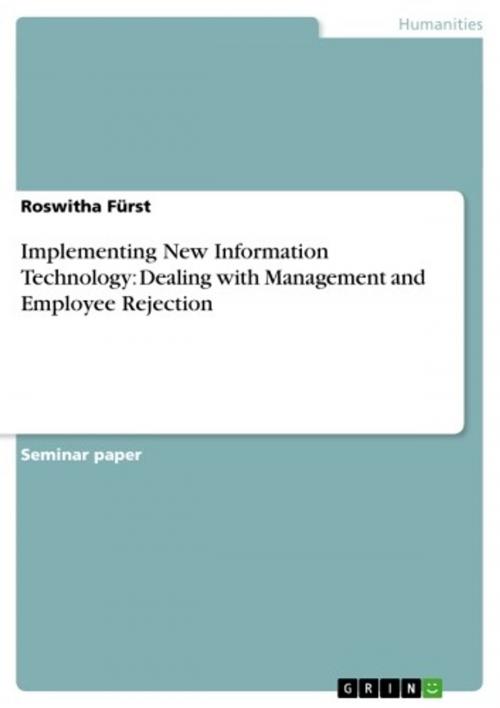Implementing New Information Technology: Dealing with Management and Employee Rejection
Nonfiction, Social & Cultural Studies, Social Science, Sociology| Author: | Roswitha Fürst | ISBN: | 9783638192897 |
| Publisher: | GRIN Publishing | Publication: | June 2, 2003 |
| Imprint: | GRIN Publishing | Language: | English |
| Author: | Roswitha Fürst |
| ISBN: | 9783638192897 |
| Publisher: | GRIN Publishing |
| Publication: | June 2, 2003 |
| Imprint: | GRIN Publishing |
| Language: | English |
Seminar paper from the year 2002 in the subject Sociology - Work, Profession, Education, Organisation, grade: 1,0 (A), Nelson Mandela Metropolitan University (School of Social Science and Humanities), course: Sociology of work: Capita Selecta, 18 entries in the bibliography, language: English, abstract: [...] You are invading the entire organization, and people need to realize the impact it is going to have.' (Campbell 2000) Usually the decision to implement a new information technology in general and an ERP system in particular depends on the economical needs of being competitive. Therefore, different reasons play a part like a fast responsiveness on customer demands, high flexibility and optimising costs through more effective processes (Doppler/Lauterburg 1994 : 41-42). Unfortunately, new information technology causes a fundamental change in the workplace. Thus, organisational change is always a challenge and often causes a rejection on the part of employees and management side since 'people are resistant to change.' (Campbell 2000) But a technology implementation is only successful with the acceptance and the support of the individuals who have to work with it (Fisher/Wesolkowski 1999; Kakabadse/Kakabadse 2000 : 235; McNamara 1999). In total, companies have to take care of how they implement technology to receive the benefits of their information technology and have to assure the ability of the staff to use it (Fisher/Wesolkowski 1999). Consequently, a way to avoid resistance2 or at least to diminish rejection has to be found. This assignment focuses on follow question: How can an organisation deal management's and employee's rejection toward implementing new information technology? Answering this question, it requires meeting two aspects: Firstly, the rejections and the reasons for resistance need to be discovered. This is important to understand rejection. Derived from this understanding, the author secondly lists suggestions for dealing with work force rejection. Thus, the possibilities as well on the personal side as on the organisational one shall be discussed. 1 According to Koch (2002) ERP (Enterprise Resource Planning) tries to integrate all functions and departments across an organisation onto a single computer system, which can deliver all those various departments' specific needs. It combines the needs of finance people, human resources an in the warehouse through a single database. Other definitions can be found in Jung/Cunningham (2001 : 7-8). 2 Resistance of change means essentially an emotional blockade built up by individuals because they fear that their situation will deteriorate through this change (Steinmann/Schreyögg 1993 : 432).
Seminar paper from the year 2002 in the subject Sociology - Work, Profession, Education, Organisation, grade: 1,0 (A), Nelson Mandela Metropolitan University (School of Social Science and Humanities), course: Sociology of work: Capita Selecta, 18 entries in the bibliography, language: English, abstract: [...] You are invading the entire organization, and people need to realize the impact it is going to have.' (Campbell 2000) Usually the decision to implement a new information technology in general and an ERP system in particular depends on the economical needs of being competitive. Therefore, different reasons play a part like a fast responsiveness on customer demands, high flexibility and optimising costs through more effective processes (Doppler/Lauterburg 1994 : 41-42). Unfortunately, new information technology causes a fundamental change in the workplace. Thus, organisational change is always a challenge and often causes a rejection on the part of employees and management side since 'people are resistant to change.' (Campbell 2000) But a technology implementation is only successful with the acceptance and the support of the individuals who have to work with it (Fisher/Wesolkowski 1999; Kakabadse/Kakabadse 2000 : 235; McNamara 1999). In total, companies have to take care of how they implement technology to receive the benefits of their information technology and have to assure the ability of the staff to use it (Fisher/Wesolkowski 1999). Consequently, a way to avoid resistance2 or at least to diminish rejection has to be found. This assignment focuses on follow question: How can an organisation deal management's and employee's rejection toward implementing new information technology? Answering this question, it requires meeting two aspects: Firstly, the rejections and the reasons for resistance need to be discovered. This is important to understand rejection. Derived from this understanding, the author secondly lists suggestions for dealing with work force rejection. Thus, the possibilities as well on the personal side as on the organisational one shall be discussed. 1 According to Koch (2002) ERP (Enterprise Resource Planning) tries to integrate all functions and departments across an organisation onto a single computer system, which can deliver all those various departments' specific needs. It combines the needs of finance people, human resources an in the warehouse through a single database. Other definitions can be found in Jung/Cunningham (2001 : 7-8). 2 Resistance of change means essentially an emotional blockade built up by individuals because they fear that their situation will deteriorate through this change (Steinmann/Schreyögg 1993 : 432).















